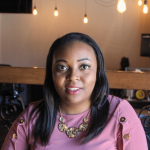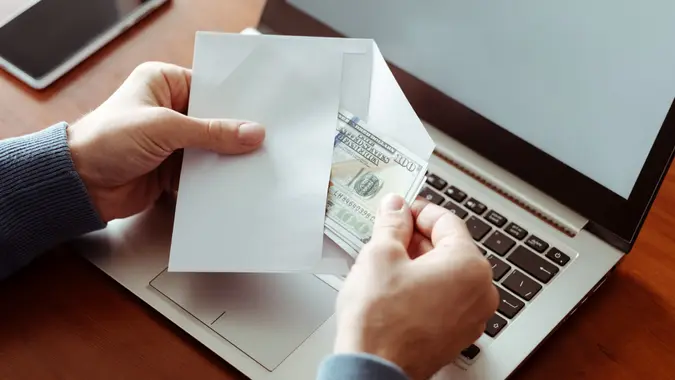The Dangerous Lie of ‘Pay Yourself First’

Commitment to Our Readers
GOBankingRates' editorial team is committed to bringing you unbiased reviews and information. We use data-driven methodologies to evaluate financial products and services - our reviews and ratings are not influenced by advertisers. You can read more about our editorial guidelines and our products and services review methodology.

20 Years
Helping You Live Richer

Reviewed
by Experts

Trusted by
Millions of Readers
You’ve probably heard the advice “Pay yourself first.” It sounds empowering, right? The idea is that before you pay a single bill, fill your gas tank or buy groceries, you should set money aside for yourself for savings, investments or debt payoff.
There’s definitely some wisdom here. Prioritizing your financial future is never a bad thing. But this strategy may not work for everyone. In fact, in certain situations, it could actually make things worse.
Before you automate savings or throw all your extra cash toward debt, it’s important to make sure your financial foundation is solid. Let’s dig into the pros, the pitfalls and what to consider before following this advice.
Also see seven tips to make your paycheck last longer in 2025.
Some Obvious Perks of Paying Yourself First
Let’s start with the good stuff. When done right, paying yourself first comes with some solid benefits.
For starters, it removes the guesswork. You don’t have to wait to see what’s left at the end of the month because your savings are already handled. It also builds strong financial habits over time. Automating your savings helps eliminate decision fatigue and reduces the temptation to spend money impulsively.
Here’s an example: Let’s say you make $3,000 a month and you set up an auto-transfer of $300 to a high-yield savings account. That’s 10% of your income consistently being saved without having to think about it. It’s great for building an emergency fund, saving for travel or making progress on long-term goals like buying a house.
And for people with consistent income and their bills already covered, this strategy often seems like a no-brainer. But what happens if your financial life is a bit more complicated?
Why This Strategy Won’t Work for Everyone
While the “pay yourself first” method works well for some, it can backfire for others — especially if their income varies, their bills aren’t caught up or their budgeting skills are still developing.
Here are a few key reasons this strategy might not be your best move right now.
Can Lead to Cash Flow Issues If Your Income Is Irregular
If you’re a freelancer, gig worker or someone whose paycheck isn’t the same every month, you may have dealt with cash flow problems at some point.
Paying yourself first assumes that your income is predictable and consistent. But when that’s not the case, transferring money to savings right away could mean you don’t have enough left for essentials later in the month. One slow week, a canceled contract or an unexpected expense could leave you scrambling.
Imagine this: You make $5,000 one month and feel great about putting $1,000 into savings. The next month, your income drops to $2,500 due to fewer jobs, but your bills are still the same, and now you’re short. That money you saved? You have to pull it right back out, maybe even with a penalty if it’s in a less liquid account.
In these cases, it may be better to pay essentials first and transfer to savings only after you know what you can realistically afford.
Doesn’t Help When You’re Not Current on Bills and Expenses
Another issue? Paying yourself first doesn’t make sense if you’re behind on rent, bills or credit card payments. In fact, it could make your situation worse.
According to CivicScience, 41% of Americans rely on credit cards to make ends meet after covering basic bills, and more than 1 in 4 buy now, pay later (BNPL) users have used these services to buy groceries, per LendingTree. These numbers show just how many people are juggling financial shortfalls.
If you’re in this boat, skipping a bill to “pay yourself first” may not build long-term wealth or stability. It often just triggers more fees, interest and stress.
Before prioritizing savings or extra debt payments, make sure your core expenses like rent, utilities, insurance and groceries are fully covered and up to date.
Funds Can Be Misused If You Don’t Have a Clear Goal for Savings
Another problem with paying yourself first? It sounds good in theory, but if you don’t have a plan for that money, it can easily be misused or become a revolving door.
Let’s say you automatically save $200 a month, but you haven’t defined what that money is for. Without a goal, it’s easy to dip into it for everyday expenses, impulse purchases or things that don’t really move you forward financially. Before you know it, your savings account becomes a temporary holding tank and not a safety net.
Instead, give your savings a name and a job. Here’s an example:
- “Emergency fund” for true unplanned expenses
- “Next car” for future vehicle replacement
- “Travel” for your summer vacation
- “Business taxes” if you’re self-employed.
Having a clear label can help you resist the urge to spend the money prematurely.
Advanced Budgeting Methods Can Be Tricky for Beginners
If you’re new to budgeting, the “pay yourself first” approach can make things more confusing, not easier.
Beginner budgeters often underestimate how much they spend, especially on periodic or surprise expenses. You might think you spend only $2,000 per month but forget about things like annual car insurance premiums, school picture day, oil changes and birthday gifts.
When you aren’t accounting for these costs, paying yourself first can cause you to fall short later. You might feel guilty or confused about where the money is going even though you’re technically “doing the right thing” by saving first.
In this case, it’s better to focus on understanding your full expense picture before building an aggressive savings plan. A clear budget gives you the foundation to save with purpose, not pressure.
What To Do Instead
If paying yourself first isn’t working, or if you’re not sure it’s the right move, here’s an approach to build financial confidence:
- Make a realistic budget: Start by writing down every fixed and variable expense you can think of. Don’t forget irregular costs that come up quarterly or annually. Tools like Simplifi, YNAB or a basic spreadsheet can help.
- Prioritize getting current: Before you start saving, focus on catching up on any past-due bills or credit card minimums. This helps you avoid late fees and protects your credit.
- Build a starter emergency fund: Aim for at least $500 to $1,000 to cover basic unexpected costs. This helps you avoid putting emergencies on a credit card while you work on other goals.
- Save with purpose: Once your essentials are handled, set up small, purposeful savings goals. Even $50 to $100 a month toward an emergency fund or travel savings can make a big difference over time.
- Revisit and adjust monthly: Your budget isn’t set in stone. Check in regularly, especially after life changes like a new job, higher bills or extra income.
In the end, paying yourself first is a great tool, but like any tool, it works only when used correctly. If the habit is helping you save consistently, stay on top of your money and meet your goals without leaving you stressed or short on cash, keep going.
But if you find yourself constantly pulling money back out of savings, missing payments or feeling confused about your money, it might be time to pause and reassess.
Financial wellness isn’t just about checking boxes. It’s about creating a system that works for you, your life and your goals.
 Written by
Written by  Edited by
Edited by 

























